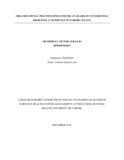| dc.contributor.author | Zimbulu, Victor | |
| dc.date.accessioned | 2017-01-05T11:50:56Z | |
| dc.date.available | 2017-01-05T11:50:56Z | |
| dc.date.issued | 2016-12 | |
| dc.identifier.uri | http://hdl.handle.net/11295/99218 | |
| dc.description.abstract | Background
Sub-optimal access to affordable essential medicines in developing countries is mainly attributable to poor availability of these medicines, mainly in the public health sector. Easy access to prescribed medicines is routinely cited by healthcare consumers as the most important measure of quality of care, the absence of which contributes significantly to the under-utilization of public health services. This study determined the organizational practices that influence supply and hence availability of essential medicines at public hospitals in Nairobi County.
Methods
A cross-sectional survey was conducted in three County referral hospitals in Nairobi City. Hospitals were selected purposively based on a multi-level variation approach. Consenting staff in pharmacy and procurement departments were recruited for participation. Information on availability of essential medicines, procurement, inventory management and management of pharmaceutical information was collected using structured interviewer- administered questionnaires and abstraction tools. Univariate data analysis was done using Microsoft Excel ® 2010 and STATA®14. Bivariate analysis for statistical correlation was also undertaken.
Results
The proportion of medicines dispensed in full to patients at the three hospitals was 42.22 %, 48.88% and 46.66% (Mean-46%; SD-0.2%) respectively. The median availability and stock-out duration for a cluster of five tracer medicines was 75.34% (Range: 0-98%) and 90 days respectively. Almost half of all orders were not exclusive to EMLs or formulary lists. The order frequency was significantly associated with supply lead times (p=0.036). Prescribers, suppliers and end-users were not involved in quantification of medicines. Lead time for hospital based orders was shorter (1-14 days) compared to purchases by the county government (2-3 months). Procurement was principally done in an open and competitive manner though direct purchases were done as well. Insufficient and delayed funding was significantly associated with delays in the procurement process (p=0.033). Refresher training of front-line staff on procurement
procedures was uncommon. Management of inventory and pharmaceutical information were predominantly done manually.
Conclusion
County referral hospitals failed to provide all prescribed medicines to a majority of its clients due to stock-shortages. One or more commodities were lacking in stock at any given time. For a cluster of five essential medicines; the median availability was marginally low whereas the stock-out duration was significantly high. Varied pharmaceutical procurement practices were established many of which were suboptimal compared to the WHO recommended practices. | en_US |
| dc.language.iso | en | en_US |
| dc.publisher | University of Nairobi | en_US |
| dc.rights | Attribution-NonCommercial-NoDerivs 3.0 United States | * |
| dc.rights.uri | http://creativecommons.org/licenses/by-nc-nd/3.0/us/ | * |
| dc.title | Organizational practices influencing availability of essential medicines at hospitals in Nairobi county | en_US |
| dc.type | Thesis | en_US |
| dc.description.department | a
Department of Psychiatry, University of Nairobi, ; bDepartment of Mental Health, School of Medicine,
Moi University, Eldoret, Kenya | |


